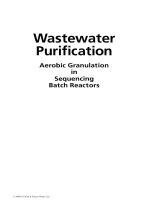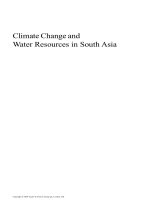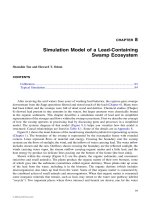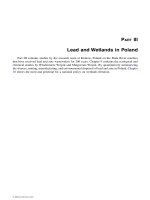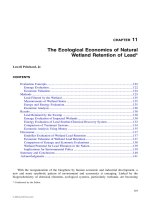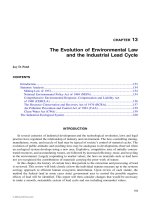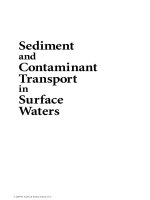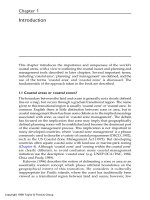Pesticide Residues in Coastal Tropical Ecosystems: Distribution, fate and effects - Chapter 1 ppt
Bạn đang xem bản rút gọn của tài liệu. Xem và tải ngay bản đầy đủ của tài liệu tại đây (957.88 KB, 31 trang )
Pesticide Residues in Coastal
Tropical Ecosystems
© 2003 Milton D. Taylor, Stephen J. Klaine, Fernando P. Carvalho, Damia Barcelo and Jan Everaarts
Pesticide Residues in
Coastal Tropical
Ecosystems
Distribution, fate and effects
Edited by
Milton D. Taylor,
Stephen J. Klaine,
Fernando P. Carvalho,
Damia Barcelo, and
Jan Everaarts
© 2003 Milton D. Taylor, Stephen J. Klaine, Fernando P. Carvalho, Damia Barcelo and Jan Everaarts
First published 2003
by Routledge
11 New Fetter Lane, London EC4P 4EE
Simultaneously published in the USA and Canada
by Routledge
29 West 35th Street, New York, NY 10001
Routledge is an imprint of the Taylor & Francis Group
© 2003 Milton D. Taylor, Stephen J. Klaine, Fernando P. Carvalho,
Damia Barcelo and Jan Everaarts
Typeset in Baskerville by
HWA Text and Data Management, Tunbridge Wells
Printed and bound in Great Britain by
MPG Books, Bodmin, Cornwall
All rights reserved. No part of this book may be reprinted or reproduced
or utilized in any form or by any electronic, mechanical, or other means,
now known or hereafter invented, including photocopying and recording,
or in any information storage or retrieval system, without permission in
writing from the publishers.
Every effort has been made to ensure that the advice and information in
this book is true and accurate at the time of going to press. However,
neither the publisher nor the authors can accept any legal responsibility
or liability for any errors or omissions that may be made. In the case of
drug administration, any medical procedure or the use of technical
equipment mentioned within this book, you are strongly advised to
consult the manufacturer’s guidelines.
British Library Cataloguing in Publication Data
A catalogue record for this book is available from the British Library
Library of Congress Cataloging in Publication Data
Pesticide residues in coastal tropical ecosystems : distribution, fate and effects /
edited by Milton D. Taylor … [et al.].
p. cm.
Includes bibliographical references and index.
1. Pesticides – Environmental aspects – Tropics. 2. Coastal ecology –
Tropics. I. Taylor, Milton D.
QH545.P4 P44796 2002
628.5´29´0913–dc21 202072711
ISBN 0–415–23917–6
© 2003 Milton D. Taylor, Stephen J. Klaine, Fernando P. Carvalho, Damia Barcelo and Jan Everaarts
Contents v
Contents
List of figures vii
List of tables x
List of contributors xvii
Foreword xxi
List of abbreviations xxiv
1 Introduction 1
FERNANDO CARVALHO, STEPHEN J. KLAINE AND
MILTON D. TAYLOR
2 Pesticides in the marine environment of Ghana 8
S. OSAFO ACQUAAH AND E. FREMPONG
3 Pesticide use in Zimbabwe: impact on Lake Kariba,
a tropical freshwater ecosystem 21
MARK F. ZARANYIKA
4 Pesiticdes in Kenya 49
S.O. WANDIGA, J.O. LALAH AND P.N. KAIGWARA
5 Distribution, fate, and effects of pesticides in the
tropical coastal zones of India 81
K. RAGHU, G.G. PANDIT, N.B.K. MURTHY, A.M. MOHAN RAO,
P.K. MUKHERJEE, S.P. KALE AND J. MITRA
6 Pesticides in Bangladesh 137
M.A. MATIN
7 Pesticide use in Malaysia: trends and impacts 159
ABDUL RANI ABDULLAH
© 2003 Milton D. Taylor, Stephen J. Klaine, Fernando P. Carvalho, Damia Barcelo and Jan Everaarts
vi Contents
8 Distribution, fate, and impact of pesticides in the
tropical marine environment of Vietnam 180
DANG DUC NHAN
9 Pesticides in the People’s Republic of China 220
ZHONG CHUANGGUANG, CHEN SHUNHUA, CAI FULONG,
LIAO YUANQI, PEN YEFANG AND ZHAO XIAOKUI
10 Ecotoxicology of pesticides in Philippine aquatic
ecosystems 271
CRISTINA M. BAJET
11 Pesticides in the coastal zone of Mexico 311
F. GONZÁLEZ–FARIAS
12 The use of pesticides in Costa Rica and their impact
on coastal ecosystems 338
ELBA M. DE LA CRUZ AND LUISA E. CASTILLO
13 Pesticides in Colombia: their application, use and
legislation 374
LUZ ANGELA CASTRO
14 Pesticide use in Cuban agriculture, present and
prospects 400
GONZALO DIERKSMEIER, PURA MORENO, R. HERNÁNDEZ
AND K. MARTINEZ
15 Use, fate, and ecotoxicity of pesticides in Jamaica and
the Commonwealth Caribbean 425
AJAI MANSINGH, DWIGHT E. ROBINSON AND KATHY M. DALIP
16 Coastal watershed-based ecological risk assessment –
Gulf of Mexico 464
STEPHEN J. KLAINE AND FOSTER L. MAYER
17 Summary 511
MILTON D. TAYLOR AND STEPHEN J. KLAINE
Appendix: Listing of all presticides mentioned, identification numbers
and activities 521
© 2003 Milton D. Taylor, Stephen J. Klaine, Fernando P. Carvalho, Damia Barcelo and Jan Everaarts
vii
Figures
2.1 Map of Ghana showing the ten administrative regions
and the marine coastline on the Gulf of Guinea 9
3.1 Lake Kariba with inflows from Zimbabwean rivers 23
3.2 Agro-ecological regions of Zimbabwe 29
3.3 Zimbabwe with its major drainage systems 30
3.4 Distribution of G. morsitans and G. pallidipes in S.E.
central Africa 30
3.5 Distribution of G. morsitans in Zimbabwe, southern
Mozambique and South Africa in 1959 31
3.6 Areas sprayed with DDT in the Zambezi valley between
1982 and 1985, and in 1988 34
3.7 Annual use of DDT for tsetse control in Zimbabwe 1981–90 34
3.8 Areas sprayed for malaria control between 1981 and 1993 36
4.1 The agroecological zones of Kenya 50
4.2 Map of the Tana River basin showing irrigation schemes and
other developments 63
4.3 Drainage map of Kenya 65
5.1 A map of India showing topographical details relevant for
pesticide movement 84
5.2 The percentage distribution of accounted land area in India
by use 85
5.3 Percentage consumption of pesticides by use category in India 89
5.4 Percentage of pesticide use in various crops in India 89
5.5
14
C-DDT distribution in different compartments of a model
ecosystem 121
6.1 Pesticide consumption in Bangladesh from 1973–95 140
6.2 Distribution of pesticides classified by function and insecticides
by chemical group 141
6.3 Removal of DDT by water washing of dried fish treated
with
14
C-DDT 146
6.4 Distribution of DDT residues in a marine microcosm 152
7.1 The location of major agricultural areas by crop in Peninsular
Malaysia 161
© 2003 Milton D. Taylor, Stephen J. Klaine, Fernando P. Carvalho, Damia Barcelo and Jan Everaarts
viii Figures
7.2 Change in the area planted in oil palm, rubber, cocoa, and
rice in Malyasia for the years 1980, 1990, and 1995 162
8.1 Major agricultural zones in Vietnam 190
9.1 Schematic drawing of a miniature model ecosystem 260
10.1 Geopolitical map of the Philippines showing island and
region groupings and surrounding east Asian seas 272
10.2 Fish production in the Philippines, 1995 273
10.3 Pesticide importation statistics in the Philippines for the period
1985–92 276
10.4 Pesticide sales, usage, and trends in the Philippines for the
period 1993–96. 277
10.5 Cross-section of a typical rice fish field 284
10.6 Aquaculture in the Philippines 292
11.1 Estimate of the quantity of pesticides used in Mexico from
1950–95 312
11.2 Classes of pesticides imported by Mexico (A) and their countries
of origin (B) 313
11.3 Change in the number of authorized insecticides for the
different chemical groups for 1988 and 1996 316
11.4 Percentage of total pesticides used in Mexico by activity (A)
and by class (B) 320
11.5 Location of the coastal states of Mexico 321
11.6 Total agricultural area (ha × 10
3
) and irrigated land (ha × 10
3
)
of each coastal state in Mexico 323
11.7 Frequency of occurrence of the most common pesticides per
sample as reported in studies published from 1977–97 329
11.8 Number of different pesticide residues reported for each
coastal state in Mexico 330
12.1 Costa Rica’s location and primary river systems 339
12.2 Tons of formulated pesticides imported by Costa Rica from
1970–96 343
12.3 Tons of pesticide a.i.(s) imported by Costa Rica from 1992–97
and the cost of pesticide a.i.(s) imported from 1992–97 346
12.4 Biocides by class imported by Costa Rica during: 1977–79,
1985–87, and 1995–97 348
12.5 Extension (ha × 1,000) and regional distribution of major crop
production in Costa Rica 351
12.6 Pesticide residues (µg kg
–1
fw) reported for coastal and natural
freshwater biota of Costa Rica 362
12.7 Pesticide residues (µg L
–1
) in surface waters of Costa Rica from
1992–98 365
13.1 The geographic location of Colombia 375
13.2 The natural regions of Colombia 378
13.3 The hydrographic basins of Colombia 379
© 2003 Milton D. Taylor, Stephen J. Klaine, Fernando P. Carvalho, Damia Barcelo and Jan Everaarts
Figures ix
14.1 Map of the Cuban Archipelago showing the major rice
production areas 403
14.2 Degradation of carbofuran in a typical rice soil 411
14.3 Sampling sites at Dayamgua Beach, Cuba 414
14.4 Channel system for the study of adsorption behavior of
pesticides in a water/sediment system 417
15.1 Map of the Caribbean Basin showing major islands and island
groups 426
15.2 Topography of Jamaica 427
15.3 The watersheds of Jamaica and geographic distribution of the
major agricultural crops of Jamaica 428
15.4 Integrated management of pests and pesticides in tropical island
ecosystems: a prospectus 433
16.1 Relationship between land use and aquatic ecosystems in small,
developed suburban watersheds 489
16.2 Relationship between rainfall, water runoff, and contaminant
transport for different land uses 497
16.3 Incorporation of exposure scenarios into watershed model to
facilitate hypothesis formulation and prioritization 498
© 2003 Milton D. Taylor, Stephen J. Klaine, Fernando P. Carvalho, Damia Barcelo and Jan Everaarts
x Tables
Tables
2.1 Trade names of agrochemicals, classified by use, used by
farmers from the Ashanti, Brong Ahafo, eastern, and western
regions of Ghana 15
2.2 Organochlorine pesticide residues in water, sediment, tomato,
and human fluids in a vegetable farming community located in
the Ashanti Region of Ghana 17
3.1 The physical dimensions of Lake Kariba, Zimbabwe at the
normal operating water level 22
3.2 Pesticides used in Zimbabwe: grouped according to chemical
classes of the compounds 25
3.3 List of commonly used dipping chemicals in Zimbabwe 27
3.4 Spraying operations using 3.1 percent dieldrin emulsion in
the south-east Zimbabwe–Mozambique border region
1962–67 33
3.5 Spraying operations in the south-east Zimbabwe–
Mozambique border region 1968–71 33
3.6 Use of endosulfan in the Gokwe District of Zimbabwe 35
3.7 Pesticide residues (mg kg
–1
dw) in animal tissue from different
localities in Zimbabwe 37
3.8 Pesticide residues in biological samples from various localities
in Zimbabwe (µg g
–1
dw) 38
3.9 OC insecticide residues in 15 crocodile eggs (µg g
–1
dw) from
Lake Kariba, Zimbabwe 42
3.10 OC insecticide and PCB residues in crocodile eggs from
Zimbabwe (µg g
–1
dw) 43
3.11 Levels of residues of DDT and its metabolites in fat of
crocodiles (pg
–1
dw fat
a
) from seven localities on the shoreline
of Lake Kariba, Zimbabwe 44
3.12 Average values (ng g
–1
dw) of DDT, HCH, aldrin and DDT/
∑ DDT for fish from Lake Kariba, Lake Chivero, and Mazvikadei
Dam, Zimbabwe 45
© 2003 Milton D. Taylor, Stephen J. Klaine, Fernando P. Carvalho, Damia Barcelo and Jan Everaarts
Tables xi
3.13 ∑ DDT, ∑ Drins, ∑ DDE, endosulfan, heptachlor, and
∑ DDE/∑ DDT ratios in sediments from the Charara (C),
Nyaodza (N), Gachegache (G), Sanyati (S), Ume (UN),
Sengwa (SN), and Ruzirukuru (Rz) River bays around Lake
Kariba, Zimbabwe (in ng g
–1
dw) 45
4.1 Pesticides banned or in restricted use in Kenya (from the Pest
Control Products Board) 53
4.2 Importation of different groups of pesticides into Kenya
(1986–95) (value) 54
4.3 Importation of different groups of pesticides into Kenya
(1986–95) (weight) 55
4.4 Importation of different groups of pesticides into Kenya
(1986–95) (percentage of total imports) 55
4.5 Importation of some pesticides into Kenya (1986–92) 55
4.6 Some pesticides used in Kenya 58
4.7 Important pests and control measures taken in Tana River
district (1992 and 1993) 64
4.8 Pesticide residues found in fish tissues 67
4.9 Reported level of ∑ DDT residues in fish from Kenyan lakes 69
4.10 OC pesticide residues in fish from Masinga Dam on the
Tana River 69
4.11 Dissipation of DDT, DDE, and lindane in Kenyan soils 71
5.1 Pesticide residues in marine, estuarine, and fresh waters of India 98
5.2 OC pesticide residues in plankton samples from Indian waters 100
5.3 Pesticide residues in marine, estuarine and freshwater
sediments of India 104
5.4 OC pesticide and PCB residues in bivalves from Indian waters 107
5.5 OC pesticide residues in fish from Indian waters 110
5.6 DDT residues in ng g
–1
ww from different types of fish from
Indian waters 112
5.7 OC pesticide residues in marine, estuarine, and freshwater
organisms of India 114
5.8 OC pesticide and PCB residues in resident and migratory
birds of India 118
5.9 OC pesticide and PCB residues in foodstuffs collected from
different locations in India 126
6.1 Principal pests of important crops in Bangladesh 143
6.2 List of registered pesticides (a.i.) in Bangladesh 144
6.3 Pesticides recommended (registered) for rice fields in
Bangladesh with application rates 145
6.4 Region-wise crop area and pesticide (formulation) consumption
in Bangladesh 147
6.5 Pesticide residues in food and the environment in Bangladesh 149
© 2003 Milton D. Taylor, Stephen J. Klaine, Fernando P. Carvalho, Damia Barcelo and Jan Everaarts
xii Tables
7.1 Estimate of the pesticide market in Malaysia (US$ M) 162
7.2 Commonly used pesticides in oil palm, rubber, cocoa, and
rice in Malaysia 163
7.3 OC pesticide residues in the aquatic environment of Malaysia 169
7.4 OC pesticide residues in marine biota from Malaysian waters 170
7.5 Some acute toxicity data on local Malaysian aquatic species 173
7.6 Bioaccumulation of insecticides in paddy field fish in Malaysia 174
7.7 Area used for aquaculture in Malaysia in 1993 175
8.1 List of pesticides banned from use in Vietnam 183
8.2 List of restricted use pesticides in Vietnam 184
8.3 The most used pesticides for agricultural purposes in Vietnam 185
8.4 List of pesticides used by vegetable farmers around Hanoi
and the percentage of farmers using each pesticide 186
8.5 OC pesticide and PCB residues in foodstuffs collected from
different locations in Vietnam 188
8.6 Seasonal (dry vs rainy) changes in concentrations of chlorinated
pesticides and PCBs (as Arochlor 1254) in surface sediment
samples from the Red River Delta, Vietnam 194
8.7 Concentrations of chlorinated pesticides and PCBs (as
Arochlor 1254) in surface sediment samples collected from
various locations around Vietnam 195
8.8 Seasonal (dry vs rainy) changes in concentrations of chlorinated
pesticides and PCBs (as Arochlor 1254) in freshwater and
marine biota from the Red River Delta, Vietnam 199
8.9 Concentrations of chlorinated pesticides and PCBs (as
Arochlor 1254) in marine and freshwater biota collected
during the rainy season in various locations in northern
Vietnam 201
9.1 Maximum permitted residue levels (MRLs) of BHC and
DDT in food from GBn53-77 228
9.2 China’s air quality standards (mg m
–3
) for harmful substances in
the workplace 228
9.3 The quantities and types of pesticides produced in China for
the period 1993 to mid-1995 238
9.4 Some pyrethroid pesticides produced in China during 1991–94 239
9.5 Listing of pesticides produced in China by year of
commercial production 240
9.6 The half-life of some herbicides in crops and soils 245
9.7 Residue levels of DDT and BHC in sediment of some coastal
regions of China 248
9.8 Residue levels (ng L
–1
) of ∑ DDT and ∑ BHC in sea water of
coastal areas of the South and East China seas 250
9.9 Residue levels of OCs (excluding the DDTs and BHCs) in water
and sediment of some coastal regions of China 251
© 2003 Milton D. Taylor, Stephen J. Klaine, Fernando P. Carvalho, Damia Barcelo and Jan Everaarts
Tables xiii
9.10 Residue levels of DDT and BHC in marine fish and bivalve
samples from Bohai Bay and Hangzhou Bay in the early 1980s 252
9.11 Concentration factors of DDT and fenvalerate in organs of
some marine organisms after 24 h exposure to DDT and 12 h
exposure to fenvalerate 256
9.12 Half-life of DDT and fenvalerate in the organs of some marine
organisms 257
9.13 Fate of C
14
labeled pesticides in miniature model ecosystems 259
9.14 Studies conducted using 17
14
C-labeled pesticides in marine and
freshwater species of the People’s Republic of China 261
9.15 Quantity of pesticides used in two rice fields of Dasha
township during the period 1970–83 before and after
introduction of IPM 265
9.16 Comparison of pesticide residues in IPM area of Dasha
township and a nearby chemical pest management (CPM)
area based on a 1978 study 266
10.1 Nationwide monitoring for pesticide residues in markets of the
Philippines 280
10.2 Monitoring of pesticide residues in vegetables (based on fresh
weight) of Laguna Province, Philippines 281
10.3 Monitoring of pesticide residues in sediment and water from
tributaries of Manila Bay, Philippines 289
10.4 Some pesticide levels in fish liver samples from Manila Bay,
Philippines 290
10.5 Aquaculture production and area under cultivation by type of
culture, 1995 293
10.6 Toxicity of some insecticides to Nile tilapia (Oreochromis niloticus L.)
fingerlings under laboratory conditions 296
10.7 Bioconcentration of pesticides in fish from the Philippines 297
10.8 Concentration of butyltins and OCs (ng g
–1
ww) in green mussels
from coastal waters of the Philippines 299
11.1 Pesticides banned from importation, fabrication, formulation,
commercialization, and use or restricted in Mexico 315
11.2 Change in legal status of OC insecticides between 1988 and
1996 as listed in Mexico’s Official Catalog of Pesticides 318
11.3 The most used insecticides in the Culiacan River Valley, Sinaloa
(northwest Mexico), for the summer of 1997, and in the coastal
zone of the Gulf of Mexico 319
11.4 Geographic characteristics of the coastal states of Mexico 322
11.5 Coastal state’s crop production exceeding 10 percent of total
country production (TCP) 324
11.6 Concentration of pesticide residues (highest values) reported
from 1977 to 1998 for the coastal states of Mexico 326
© 2003 Milton D. Taylor, Stephen J. Klaine, Fernando P. Carvalho, Damia Barcelo and Jan Everaarts
xiv Tables
12.1 Pesticides with prohibited or restricted use in Costa Rica 342
12.2 The 25 most imported pesticides in Costa Rica from 1985–97 345
12.3 Major pesticide a.i. imported from 1995–97 in Costa Rica 347
12.4 Total cultivated area (ha), quantity of a.i. and formulated
pesticides utilized per ha (in kg), and quantity of a.i. (in kg)
per person imported by Costa Rica from 1992–97 349
12.5 Number of hectares cultivated for major crops harvested in
Costa Rica, per ha pesticide a.i. use for each crop, and total
quantity of a.i.(s) used per crop 350
12.6 Quantity of pesticide a.i. (T) imported during 1995–97 by
Costa Rica (CR), the Punta Morales formulating plant (PM),
and by companies directly related to banana cultivation (BC) 350
12.7 Adverse environmental impacts associated with crop
production cycles, emissions, and ecosystem exposure associated
with the crop production life cycle 352
12.8 Pesticides imported by a formulation plant located on the Nicoya
Gulf (northwestern Pacific Coast of Costa Rica) and their aquatic
toxicity to laboratory organisms 355
12.9 Summary of pesticide studies in aquatic ecosystems near shore
in Costa Rica 357
13.1 Sales of pesticides in Colombia, according to type of product
1975–95 381
13.2 Total area under cultivation in Colombia, 1995 382
13.3 Market composition of pesticide groups by crop for 1991 in
Colombia 383
13.4 Use of pesticides in Colombia and other Latin American
countries based on use data for the period 1982–84 384
13.5 Pesticides: national sales, importation for domestic use and
exports for 1988–95 in metric tonnes 385
13.6 Principal active ingredients marketed in Colombia during 1995 386
13.7 Production, sales, imports and exports of pesticides in Colombia
during 1995 387
13.8 Concentration of OC pesticides detected in waters of Colombia’s
Caribbean Coast 389
13.9 Concentration of OC pesticides detected in sediments and soil
along Colombia’s Caribbean coast 389
13.10 Chronology of Colombian legislation to prohibit the production,
importation, trade, or use of 21 specific pesticides 393
14.1 Pesticides authorized for use in rice cultivation 403
14.2 Desorption of pesticides in two Cuban soil types 404
14.3 Pesticides banned from use in Cuba 408
14.4 Specific adsorption constants (K) for selected pesticides in two
important Cuban agricultural soils 408
© 2003 Milton D. Taylor, Stephen J. Klaine, Fernando P. Carvalho, Damia Barcelo and Jan Everaarts
Tables xv
14.5 Leaching of selected pesticides in two Cuban soil types 409
14.6 Upward capillary movement of selected herbicides in a Cuban
red ferralitic soil 410
14.7 Dissipation of triazine herbicides in a Cuban red ferralitic soil
under field conditions 410
14.8 Pesticide residues in soil after application or harvest 411
14.9 Dissipation of DDT and dieldrin under field conditions in
a Cuban red ferralitic soil 412
14.10 Behavior of pesticides in water-sediment systems 413
14.11 Total ∑ DDT and its metabolites found in sediment and biota 415
14.12 OP residues in field samples 415
14.13 Dynamic adsorption of pesticides under field conditions 416
14.14 Pesticide residues found in samples of some important crops
in Cuba 421
15.1 Agricultural use of land in different Commonwealth Caribbean
countries 429
15.2 Area cultivated and annual consumption of pesticides in Jamaica
by major crops based on a survey of farmers by the authors and
data from each Commodity Board or Association 430
15.3 Amount (kg) of pesticides imported into Commonwealth
Caribbean countries 435
15.4 Laboratory and field data on the dissipation and degradation
of selected pesticides in the Jamaican environment 445
15.5 Persistence of various insecticides in different Jamaican soil
types at 15 percent moisture level as determined by laboratory
bioassay 447
15.6 Residues of OC and OP insecticides detected in rivers of some
Jamaican watersheds 449
15.7 Residues of OC and OP insecticides detected in selected
Jamaican rivers sampled during a rapid survey in 1994 451
15.8 Residues of OC insecticides detected in water, flora and
fauna in the Caroni Swamp in Trinidad and coastal waters
of St Lucia 453
15.9 Toxic symptoms displayed by the shrimp Macrobrachium faustinum
and the fish red Tilapia hybrid exposed to sub-lethal
concentrations of different insecticides 457
15.10 LC
50
levels of various insecticides for the shrimp
Macrobrachium faustinum and the fish red Jamaican Tilapia hybrid
determined under static laboratory conditions 458
16.1 Gulf of Mexico resources: endangered, threatened, and
proposed species 471
16.2 Gulf of Mexico commercial fish resources: commercial
landings from Gulf waters for 2000 listed in order of
commercial value 473
© 2003 Milton D. Taylor, Stephen J. Klaine, Fernando P. Carvalho, Damia Barcelo and Jan Everaarts
xvi Tables
16.3 Species data for commercial and recreational mollusc,
crustacean, and fish resources mentioned in the chapter 474
16.4 Gulf of Mexico recreational fish resources: economic impact 478
16.5 Significant Gulf of Mexico chemical stressors 485
16.6 Examples of aquatic resources in the ERA conceptual model 499
© 2003 Milton D. Taylor, Stephen J. Klaine, Fernando P. Carvalho, Damia Barcelo and Jan Everaarts
Contributors xvii
Contributors
Many of the book’s authors or their representatives were among the coordinated
research program attendees at the International Symposium on Marine Pollution held in
Monaco, 5–9 October 1998. Standing from left to right are Cai Fulong (PRC), Lily Varca
(Philippines), Jahan (Bangladesh), Ajai Mansingh (Commonwealth Caribbean), Dang Duc
Nhan (Vietnam), Tania Tavares (Brazil) Luz Angela Castro (Colombia), Elba M. de la Cruz
(Costa Rica), F. González-Farias (Mexico), S.P. Kale (India), Damia Barcelo (Spain),
Stephen J. Klaine (USA), Gonzalo Dierksmeier (Cuba) and Abdul Rani Abdullah
(Malaysia). Seated or kneeling in the front row are Fernando Carvalho (IAEA),
Shem O. Wandiga (Kenya) and Zhong Chuangguang (PRC).
© 2003 Milton D. Taylor, Stephen J. Klaine, Fernando P. Carvalho, Damia Barcelo and Jan Everaarts
xviii Contributors
Abdul Rani Abdullah Department of Chemistry, University of Malaya, 50603,
Kuala Lumpur, Malaysia.
Cristina M. Bajet Pesticide Toxicology and Chemistry Laboratory, National
Crop Protection Center, University of the Philippines at Los Baños, College,
Laguna 4031, Philippines.
Damia Barcelo CSIC, CID, Department of Environmental Chemistry C Jordi
Girona Barcelona, Spain
Cai Fulong Third Institute of Oceanography, State Oceanic Administration,
Xiamen, People’s Republic of China.
Luisa E. Castillo Central American Institute for Studies in Toxic Substances,
Universidad Nacional, Costa Rica.
Fernando P. Carvalho Instituto Tecnológico e Nuclear, Dpto Protecção Radio-
lógica, E.N. 10 P-2685-953 Sacavém, Portugal.
Luz Angela Castro
Centro Control Contaminación del Pacífico (CCCP), Sección
Contaminación Marina. Isla del Morro, Tumaco – Nariño, Colombia S.A.
Chen Shunhua School of Life Sciences, Zhongshan University, Guangzhou
510274, People’s Republic of China.
Elba M. de la Cruz Central American Institute for Studies in Toxic Substances,
Universidad Nacional, Costa Rica.
Kathy M. Dalip Pesticide and Pest Research Group, Department of Life Sciences,
University of the West Indies, Mona, Kingston 7, Jamaica. Current Affiliation:
Senior Entomologist, Caribbean Agriculture Research and Development
Institute, University of the West Indies, Mona, Kingston 7, Jamaica.
Dang Duc Nhan Vietnam Atomic Energy Commission, 59 Ly Thuong Kiet,
Hanoi, Vietnam.
Gonzalo Dierksmeier Plant Protection Research Institute, 110 No. 514 esq.
5taB Playa, Habana City, Cuba.
Jan Everaarts Netherlands Institute for Sea Research AB Den Burg-Textel The
Netherlands
E. Frempong Department of Biological Sciences, University of Science and
Technology, Kumasi, Ghana.
F. González-Farias Center for Nutrition Research and Development (CIAD),
Mazatlan Unit in Aquaculture and Environmental Management. P.O. Box 711,
Mazatlan, Sin. México 82000. Permanent address: National Autonomous
University of México, Institute of Marine Science and Limnology, Mazatlan
Marine Station. P.O. Box 811, Mazatlan, Sin. México 82000.
© 2003 Milton D. Taylor, Stephen J. Klaine, Fernando P. Carvalho, Damia Barcelo and Jan Everaarts
Contributors xix
R. Hernández Plant Protection Research Institute, 110 No. 514 esq. 5taB Playa,
Habana City, Cuba.
P.N. Kaigwara University of Nairobi, Department of Chemistry, P.O. Box 30197,
Nairobi, Kenya.
S.P. Kale Nuclear Agriculture and Biotechnology Division, Bhabha Atomic
Research Centre, Mumbai 400 085, India.
Stephen J. Klaine Department of Environmental Toxicology, Clemson Institute
of Environmental Toxicology, Clemson University, Pendleton, SC USA 29670.
J.O. Lalah University of Nairobi, Department of Chemistry, P.O. Box 30197,
Nairobi, Kenya.
Ajai Mansingh Pesticide and Pest Research Group, Department of Life Sciences,
University of the West Indies, Mona, Kingston 7, Jamaica. Current Affiliation:
Natural Products Institute, University of the West Indies, Mona, P.O. Box 12,
Kingston 7, Jamaica.
K. Martinez Plant Protection Research Institute, 110 No. 514 esq. 5taB Playa,
Havana City, Cuba.
M.A. Matin Institute of Food and Radiation Biology, Atomic Energy Research
Establishment, GPO Box 3787, Dhaka-1000, Bangladesh
Foster L. Mayer United States Environmental Protection Agency (USEPA),
Environmental Research Lab, Gulf Breeze, FL USA 32561.
J. Mitra Nuclear Agriculture and Biotechnology Division, Bhabha Atomic
Research Centre, Mumbai 400 085, India.
A.M. Mohan Rao Environmental Assessment Division, Bhabha Atomic Research
Centre, Mumbai 400 085, India.
Pura Moreno Plant Protection Research Institute, 110 No. 514 esq. 5taB Playa,
Havana City, Cuba.
P.K. Mukherjee Nuclear Agriculture and Biotechnology Division, Bhabha
Atomic Research Centre, Mumbai 400 085, India.
N.B.K. Murthy Nuclear Agriculture and Biotechnology Division, Bhabha Atomic
Research Centre, Mumbai 400 085, India.
S. Osafo Acquaah Department of Chemistry, University of Science and Tech-
nology, Kumasi, Ghana.
G.G. Pandit Environmental Assessment Division, Bhabha Atomic Research
Centre, Mumbai 400 085, India.
K. Raghu Nuclear Agriculture and Biotechnology Division, Bhabha Atomic
Research Centre, Mumbai 400 085, India.
© 2003 Milton D. Taylor, Stephen J. Klaine, Fernando P. Carvalho, Damia Barcelo and Jan Everaarts
xx Contributors
Dwight E. Robinson Pesticide and Pest Research Group, Department of Life
Sciences, University of the West Indies, Mona, Kingston 7, Jamaica. Current
Affiliation: Natural Products Institute, University of the West Indies, Mona,
P.O. Box 12, Kingston 7, Jamaica.
Milton D. Taylor Department of Environmental Toxicology, Clemson Institute
of Environmental Toxicology, Clemson University, Pendleton, SC USA 29670.
S.O. Wandiga University of Nairobi, Department of Chemistry, P.O. Box 30197,
Nairobi, Kenya.
Pen Yefang School of Life Sciences, Zhongshan University, Guangzhou 510274,
People’s Republic of China.
Liao Yuanqi The Plant Protection Research Institute, Guangdong Academy of
Agricultural Sciences, Guangzhou, People’s Republic of China.
Mark F. Zaranyika Chemistry Department, University of Zimbabwe, P.O. Box
MP 167 Mount Pleasant, Harare, Zimbabwe.
Zhao Xiaokui School of Life Sciences, Zhongshan University, Guangzhou
510274, People’s Republic of China.
Zhong Chuangguang School of Life Sciences, Zhongshan University,
Guangzhou 510274, People’s Republic of China.
© 2003 Milton D. Taylor, Stephen J. Klaine, Fernando P. Carvalho, Damia Barcelo and Jan Everaarts
Foreword xxi
Foreword
The second half of the twentieth century saw tremendous increases in world food
production brought about by revolutionary changes in agriculture. With the
introduction and widespread acceptance of DDT as a nearly universal insecticide
for agriculture in 1944, crop losses to insects declined rapidly and food production
accelerated through a paradigm shift from small family farms to industrialized
agriculture. By the late 1960s when insect resistance to DDT and the rising concern
for environmental contamination caused by DDT and other organochlorine
pesticides became apparent, other pesticide chemistries such as the organo-
phosphates, carbamates, organotins, and second generation pyrethroids had become
available. These compounds filled the pest control gap as organochlorine use
gradually declined from the combination of resistance and environmental
regulatory pressures. The Green Revolution of the 1980s introduced high-yield
hybrid seed varieties, which in combination with chemical fertilizers, resulted in
dramatic increases in crop yields; world rice and wheat yields tripled between
1950 and the mid-1980s. With the recent development of genetically modified
transgenic crops, there has been a further shift to large-scale plantation farming.
The shift to monoculture-based industrial farming has brought about the
introduction of many new and novel pesticide chemistries, primarily because mono-
cultures are more susceptible to pest population explosions than the old-style mixed
crop planting that would sustain and promote insect predator populations.
Because of the environmental problems associated with the organochlorines,
pesticide regulatory agencies were established, initially in developed countries
located in temperate climes, and began issuing regulations to control pesticide
production and use. These regulations required data about the efficacy and non-
target effects of individual pesticides. Consequently, most of the data generated
for regulatory purposes was based on data obtained from field research in temperate
climates. Thus, guidelines for using pesticides in the tropics have been based on
research conducted in Europe and the United States. While some tropical countries
recognized the potential problems associated with this fact, they had little recourse
but to adopt regulations copied from their more affluent northern neighbors. Over
the past 20 years, many developing countries have adopted some form of environ-
mental protection, either through establishment of a regulatory agency or agencies
© 2003 Milton D. Taylor, Stephen J. Klaine, Fernando P. Carvalho, Damia Barcelo and Jan Everaarts
xxii Foreword
or through adoption of a body of law to regulate the pesticide industry. As a
result, some tropical countries are taking a more proactive approach to regulating
pesticides by requiring licensing data for individual pesticides to be generated in
soils, climates, and under conditions reflective of local conditions. This is an
encouraging sign of environmental responsibility. There are groups in some
countries, pushing for national long-term pesticide residue monitoring programs
for foodstuffs, surface waters, or biota. However, these efforts are likely to be stillborn
until and unless the international community, viz. the developed countries, assists
by providing stable long-term funding to support these efforts.
This book grew out of a research program to determine the distribution, fate,
and effects of pesticides in the tropical marine environment as envisioned and led
by Fernando Carvalho at the Marine Environmental Laboratory of the Inter-
national Atomic Energy Agency in Monaco. He recruited respected scientists from
17 countries and charged them to accomplish a specific set of objectives. These
included measuring current levels of pesticide residues in coastal environments,
characterizing the cycling and fate of pesticides, evaluating the effects of their
residues on marine biota, assessing the risk associated with pesticides in coastal
tropical ecosystems, and advising on measures to protect the tropical marine
environment. With funding provided by the Swedish International Development
Authority, a coordinated research program (CRP) was established and through
joint activities including courses on aquatic toxicology, ecological risk assessment,
and quality assurance and quality control; training workshops; and participation
in international scientific meetings, the participating scientists were forged into a
dynamic working group. As their research yielded new information about the extent
of pesticide residues in coastal environments, they became familiar with the results
of other groups working in their respective countries. The genesis of this book
came from discussions between themselves and other colleagues. As the idea
evolved, it became apparent that more than a summary of research results would
be needed to convey the potential for pesticides to affect the tropical marine environ-
ment. Contributing colleagues were asked to include some basic information about
their country, e.g., location, extent, geographic features, etc.; brief histories of
pesticide use with import and export data where available; summaries of their
pesticide regulations and descriptions of the regulatory bodies in their country;
descriptions of pesticide research in their country including residue levels in surface
waters, coastal waters, sediments and biota; and synopses of efforts in their
respective countries to limit the growth of pesticide use, either through Integrated
Pest Management efforts, public education programs, or through other means.
Readers will discover that individual chapters are not rigidly structured as some
authors tended to emphasize one area more than another. As editors, we felt that
this less-rigid format made for a more interesting book and provided some
information about a country’s focus or concerns either through inclusion or
omission. Our hope is that the resulting book will bring together as much of the
current peer-reviewed, government, and “grey” literature on pesticide use, fate,
and effects in the tropics as possible and serve as a state-of-the-science summary
© 2003 Milton D. Taylor, Stephen J. Klaine, Fernando P. Carvalho, Damia Barcelo and Jan Everaarts
Foreword xxiii
for generating the next set of research projects by scientists and serve as a basis for
management decisions regarding coastal tropical ecosystems.
Obviously, this project would never have come to fruition without the continued
efforts of its contributors to respond to editorial suggestions and supply updated
information for their respective chapters. The editors would also like to thank the
students of Professor Klaine’s laboratory in the Department of Environmental
Toxicology, Clemson University, for their assistance in reviewing page proofs of
the book.
M. D. Taylor
June 2002
Pendleton, South Carolina, USA
© 2003 Milton D. Taylor, Stephen J. Klaine, Fernando P. Carvalho, Damia Barcelo and Jan Everaarts
xxiv Abbreviations
Abbreviations
Abbreviations for the following terms and organizations are used throughout this
book. However, abbreviations for terms and organizations listed within individual
chapters are applicable only to that chapter.
AChE acetylcholinesterase
a.i.(s) active ingredient(s)
B billion
BCF bioconcentration factor
cm centimeters
d day(s)
DPM disintegrations per minute
dw dry weight
EIL economic injury level
EC emulsifiable concentrate
EPA Environmental Protection Agency
FW flowable
G granular
GDP gross domestic product
ha(s) hectare(s)
HYV high yield variety
h hour(s)
IPM Integrated Pest Management
IAEA International Atomic Energy Agency
L liter(s)
kg kilogram
LOEC lowest observed effect concentration
MRLs maximum residue levels
m meter(s)
T metric tonnes
µg micrograms
mm millimeters
M million
© 2003 Milton D. Taylor, Stephen J. Klaine, Fernando P. Carvalho, Damia Barcelo and Jan Everaarts
Abbreviations xxv
ng nanogram
NOAA National Oceanographic and Atmospheric Administration
NOEC no observed effect concentration
OC organochlorine pesticides
OP organophosphate/organophosphorus pesticides
ppb part per billion
ppm part per million
PCB polychlorinated biphenyl
POP(s) persistent organic pollutants
SC soluble concentrate
∑ total (used to denote: sum of all isomers or sum of a class)
FAO United Nations Food and Agriculture Organization
UNEP United Nations Environment Programme
UNESCO United Nations Educational, Scientific, and Cultural
Organization
WP wettable powder
ww wet weight
WHO World Health Organization
y year(s)
© 2003 Milton D. Taylor, Stephen J. Klaine, Fernando P. Carvalho, Damia Barcelo and Jan Everaarts
Introduction 1Chapter 1
Introduction
1
Fernando Carvalho, Stephen J. Klaine and
Milton D. Taylor
Since the 1940s the use of pesticides has grown steadily at about 11 percent a year,
reaching five million T in 1995. Pesticides and fertilizers play a central role in
agriculture and contribute to an enhanced food production worldwide. Agro-
chemical use, mainly in developed countries, is being reduced while organic (no
synthetic chemicals) farming methods are being reinvented. However, in most
countries, agrochemicals remain an essential component of agricultural practice
and will remain so for the foreseeable future. Pesticides, especially insecticides and
fungicides, are more heavily applied to tropical cash crops, e.g. banana, coffee,
cotton, and vegetables, than to crops in temperate regions. For example, the
application of pesticides to banana plantations in Costa Rica reached 45 kg a.i.
per ha, whereas the comparable average application of pesticides in Japan to crops
is 10.8 kg. Only a minor fraction of applied pesticides actually reaches the target
pest species – less than 0.1 percent; the excess pesticide moves through the environ-
ment potentially contaminating soil, water, and biotic matrices. It is critical,
especially in the tropics where use patterns lead to much higher loads of pesticides
than in temperate zones, to characterize the fate and non-target toxicity of these
pesticides to confidently assess the risk associated with their use.
Agricultural fields are generally located in coastal plains and river valleys so it
is not surprising that streams and rivers receive the majority of agriculture runoff
and carry the residues into estuaries and coastal seas. For example, the USA’s
Mississippi River may have transported an estimated 430 T of atrazine in 1989
from mid-western corn and soybean plantations to the Gulf of Mexico. The effect
of these pesticide residues on human and environmental health is of great concern.
Recent studies on the estrogen-like behavior of some DDTs and PCBs in humans
implicate these compounds in the etiology of breast cancer. Furthermore, the
growing awareness of the environmental persistence of organic pollutants
(pesticides and industrial organic chemicals) has led governments to agree on an
international Convention on Persistent Organic Pollutants (POPs), phasing out a
number of noxious substances, including DDT, PCBs, and other chlorinated
hydrocarbons.
Nevertheless, the use of hundreds of old and new compounds as crop-protection
chemicals continues worldwide. It is urgent that we develop strategies to facilitate
© 2003 Milton D. Taylor, Stephen J. Klaine, Fernando P. Carvalho, Damia Barcelo and Jan Everaarts
